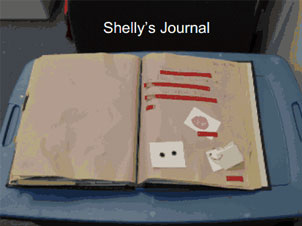Writing
Reading allows individuals to learn about the world; writing provides access to the outside world.
(Sturm, J., 2003)
The quote above acknowledges the fundamental nature of writing in our society. Writing allows an individual to make an impact on the world—for example, by signing a check or greeting card, recording thoughts in a journal, answering an essay question on a test, or writing a novel. Recognition of the importance of writing makes it imperative that all children be given the opportunity to learn to write.
Students with deaf-blindness, however, are often not given this opportunity because their families or teachers may believe that vision and hearing loss, as well as additional disabilities, make conventional writing impossible. Writing is not impossible for these children, but it may take on some unconventional forms.
Children become writers "by experimenting with writing, observing as others write, and receiving help from supportive adults" (Casberque, 1998; Dyson, 2002; McGee & Richgels, 2000). Just like other children, those with deaf-blindness need opportunities to experiment with and observe others writing, and they need assistance from families and educators who can provide them with tools and strategies that give them a chance to develop this valuable life skill.
Related Skills
Literacy skills should not be taught in isolation because they relate to numerous developmental and academic standards often being addressed by a child's educational team. Awareness of interrelated skills assists teams in IEP development and planning holistic instruction.
Attention and Response
Increased duration of active engagement with writing activities
Interaction and Communication
Use of multiple forms of communication; partial/full participation in instructional activities; use of technology (keyboard, DVD player,alternate pencils) to support learning; increased vocabulary (written independently or through use of AT)
Sensory
Use of tactile skills for sensory input
Tactile/Motor
Imitation of simple motor tasks; eye-hand coordination; tactile discrimination; holding a pencil or adapted writing instrument
Cognitive
Recall of verbal and non-verbal events; use of emergent symbolic forms (e.g. pictures and/or line drawings); answers questions about text using preferred writing method; expresses feelings/attitudes/opinions about text using preferred writing method
Examples
Shelly "writes" in her daily journal by choosing tactile representations of activities she wants to write about. Print and braille are added. The book goes home daily to provide Shelly's family with topics for conversation.

Writing in a Daily Journal (Paths to Literacy)
Step-by-step instructions for using journals with students.
Promoting Literacy through Emergent Writing (NV Dual Sensory Impairment Project)
One-page sheet that provides practical suggestions for making writing accessible and meaningful for students with significant disabilities. Can be used as a handout.
Alternative Pencils (Toby Scott)
Website providing an overview of alternative pencils, including summaries of research articles, videos of students, suggestions of writing activities, and information about assessment.
Case Studies: Jake and Matthew from Deaf-Blind Model Classroom Project (UNC Center for Literacy and Disability Studies)
User-friendly summary of an extensive research project aimed at teaching writing skills to students who had physical disabilities in addition to their vision and hearing loss. Includes video clips, photos and writing samples.
Articles
Literacy for Persons who are Deaf-Blind
Barbara Miles
Provides a general overview to the importance of literacy for individuals with deaf-blindness, including practical strategies and tips to get started.
Writing Considerations
Heller and Jones-Swinehart in Colorado Services for Children who are Deafblind Newsletter
Article on page three of newsletter. Discusses and illustrates a variety of adaptations designed to assist students with physical disabilities.
Writing and AAC
Janet M. Sturm
Discussion of the link between literacy and language development with an emphasis on how to incorporate writing into the literacy instruction of students who use augmentative communication.
Additional Resources
One-Minute Writing Context Checklist (Musselwhite and Hanser)
Checklist designed to provide a mechanism for saving student writing samples for use in showing change across time and designing effective instruction.
Emergent Literacy Interaction Inventory (UNC Center for Literacy and Disability Studies)
An inventory of key elements required by adults in order for students to learn how to write using an alternative pencil. Can be used to train teachers, teaching assistants, parents, administrators, literacy coaches, OTRs, SLPs, PTs and after school caregivers. Specifically designed for students with significant disabilities, including deaf-blindness.
PVP Pipe Easel (UNC Center for Literacy and Disability Studies)
Illustration, materials list and instructions for making the flip chart easel used with the alphabet flip chart in writing activities. The easel can also be used with the communication flip chart for other partner assisted scanning activities. Designed by Julie Brickhouse.
